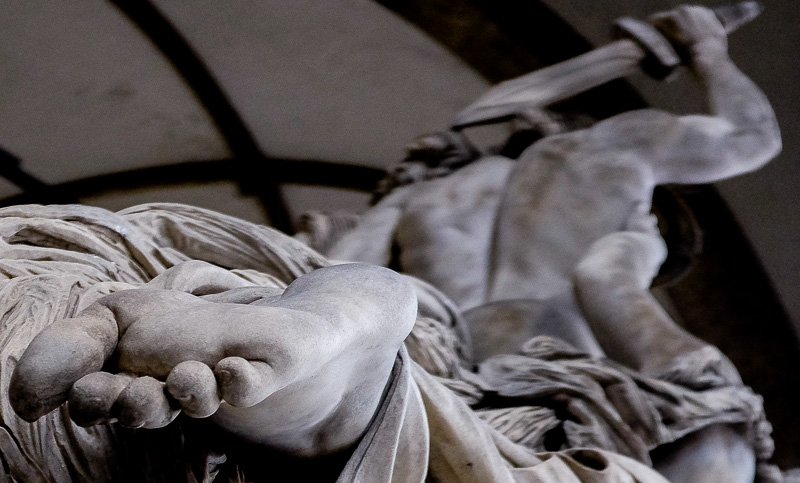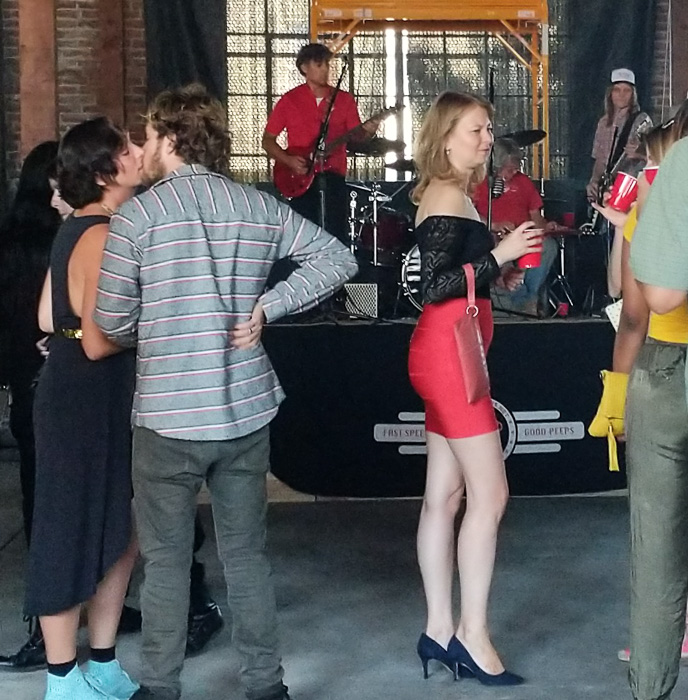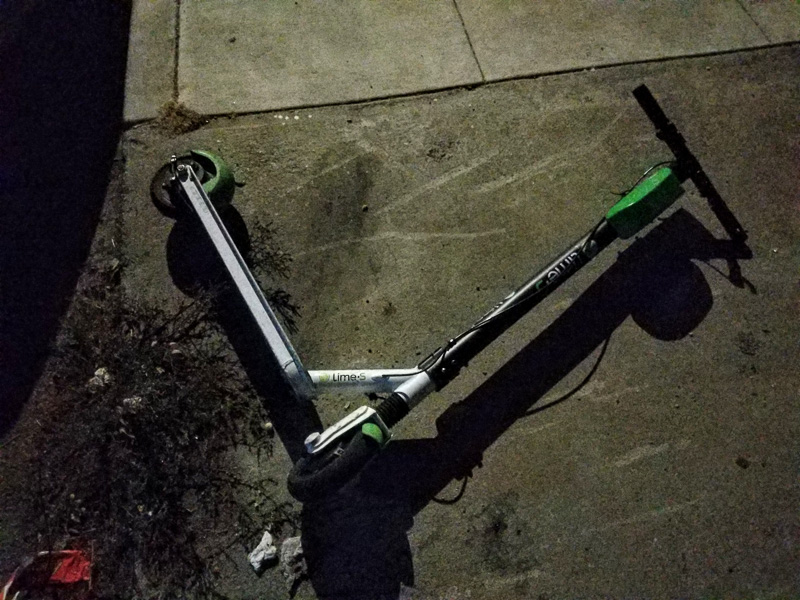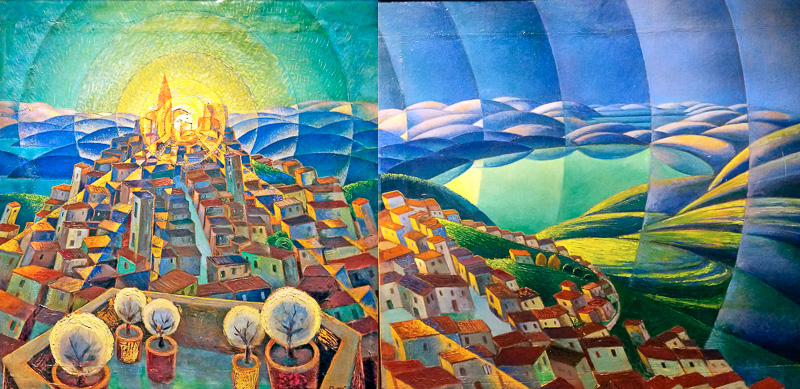This is a fairly long blog post. In my usual fashion, I’ll break up the text blocks with photos. Some of today’s images are from a recent trip to Italy. They have (at least superficially) no connection with the text. But never forget the Surrealist principle that everything illuminates everything!

“Nine Dragons” acrylic on canvas, October, 2019, 40” x 30”. Click for a larger version of the painting.
Like a Book Review
I recently read Annalee Newitz’s second novel, The Future of Another Timeline. It’s great. I was beguiled by the prose, fond of the characters, absorbed by the action, and intrigued by Newitz’s notions about time editing.

Men get harsh treatment in this book’s pages. Monstrous male villains from the future are trying to enslave women throughout all of history. The loss of voting rights and the denial of abortion rights aren’t enough for these goons. They’d like to see women who lack hands and who maybe don’t even have heads. Newitz’s heroines have max impact against these GOPpy creeps.
Meanwhile (if that word makes sense in a time travel novel) the younger versions of our characters are hanging out in the 1990s. I like their conversations. “We talked for a while about the stupidity of Disney World, and how it was like wanting to take a vacation inside a plastic replica of a vacation.” [Sorry, Cory!] And there’s a nice evocation of them at a rock concert, as seen by one of their future selves:
What really jolted me was the way people occupied themselves as they waited for the music to start. Nobody was texting or taking selfies. And without phones, people didn’t know what to do with their eyes. I didn’t either.

As well as going to rock shows, the younger characters are butchering sex-offenders in scenes of full-on horror gore. Not for the squeamish, but sick-funny in a Grand Guignol way. And, hey, they’re only killing men, so really it’s okay. No worse than squashing bugs.
To remove any lingering moral ambiguity, one of the women gives up serial killing—after a talking-to from her time-travelling future self. Newitz springs a fresh take on this normally mandatory time-travel-novel cliché.
I was wondering whether I’d ever see [my future self] Tess again. Would I grow up into her, and have to come back in time to visit myself? From what I’d learned in our unit on time travel, that was fake movie pseudoscience. It was more like her visit had reshuffled the timeline, generating a new history and future in its wake. Only Tess would remember the timeline that existed before her edit.

Regarding being a killer or not, at the very end of the novel this character realizes she was meant to be one all along.
Maybe that was why I belonged in the first century B.C.E. In Nabataean, there was a word for what I did best. There was actually a job that combined my skills as an academic and a murderer.
“I think I’d like to be an assassin.”
Hugayr smiled. “Great! We’ve really been needing one.”
The savage settling of scores is refreshing in these fraught times, and the book is a punk feminist anthem. We’ve seen enough bromantic sword-fighting, macho, jaw-jutting oink-fests, for sure. And the time travel scenes are enchanting.
Rain swarmed around us, full of fat hot drops and freezing bullets of hail, and we held each other in the void that meant history was still mutable. I concentrated on my friends, and how their breathing felt next to mine. We seemed to spin slowly, like a drifting asteroid or a diatom in the ocean’s water column.

The novel also features a thread of warm historical-fiction interplay involving women’s suffrage, family planning, belly dancing, and goddess worshipping. Things can be quite cozy when men aren’t around. And Newitz is wonderful at sketching scenes. Here’s old Chicago.
Wednesday night was humid. Sunset spread like a rash over the water, and the reek of rotting pig guts in the river mingled with smoke from roasting nuts.
Read The Future of Another Timeline! It’s cosmic, nasty, thoughtful fun.
Timeline Edits
My main goal today is to ponder the SF machinery in Newitz’s epic. The novel is about editing our timeline. That’s a geeky, techie concept I can wrap my monkey mind around. I realize that others have analyzed time travel, but rather than summarizing past efforts, I’ll wing this essay on my own.
This said, I’ll mention that a good recent survey is Damien Broderic, The Time Machine Hypothesis. And the Encyclopedia of Science Ficion, has many, many links.
I’ve thought about time travel a lot over the years. And this month a time travel story by Marc Laidlaw and me is appearing in Asimov’s: “Surfers at the End of Time.”
The idea behind timeline-editing is to change your past so your present is more like you want it to be. That is, people hop to past times, do things there, and hop back to the era where they started. When competing groups are editing the timeline you get what’s known as a “change war” or a “time war.” The Future of Another Timeline is about an ongoing time war.
But let’s back up for a second. As is known to all SF readers, timeline editing leads to odd situations. Suppose I’m sick of the corrupt and evil Premier Treadle. I hop back seventy years and drown him as a lad. Then I hop back to our present day. No more Treadle. Hooray!

But wait. Assuming my memories remain intact, I’ll notice that the present which I return to is not the same as the present I started from. It used to have Treadle, and now it doesn’t. How can one and the same present have two different forms?
The paradox gets particularly intense if you go back in time and depressively kill your own self as a child. If you then hop back your starting time, you’re in a world where you yourself have been dead for decades. So how can you even exist?

A separate issue is the fact that when we’re doing timeline-editing, or doing any kind of time travel at all, we get into different dimensions or levels or directions of time. That is, if I talk about the former, unedited version of my present as being in my personal “past,” that means that my life’s individual timeline is distinct from the world’s overall timeline.
Getting all lit-crit on your ass, the actions of time travelers are narrated as a (harrumph) diegesis, that as in a POV stream of experience that includes its own arrow of time. The individual’s diegetic time can be distinct from the world’s time. This is a large and stinky elephant in the living room, and it’s not often discussed.
So I’ll get back to elephant in a minute, but let’s say a bit more about the paradox issue first.
Option 1: Paradoxes Don’t Happen
One option is just to insist that the paradoxes don’t happen. You go back in time planning to kill young Treadle but, for whatever reason, you somehow don’t manage to. Or you go back and kill your earlier self, and maybe it seems like you’re successful, but guess what, your earlier self does not in fact really die, they have a miraculous recovery, accompanied by complete amnesia about nearly being killed, so there’s not paradox.
This move appears in a number of Golden Age time-travel stories.

And it’s the route that Marc Laidlaw and I recently took in our story “Surfers at the End of Time”, as I describe it in my on it post on it. I once had a chance to discuss time travel with the god-like logician Kurt Gödel, and he said, “Why not suppose that the world always arranges itself so that these paradoxes do not occur. If something is logically impossible, then it doesn’t happen. A priori logic is very powerful.”
Option 2: Multiple Timelines
The standard boilerplate time-travel-novel move is to say that, when you hop back in time, you don’t enter the the past of your own original timeline, which we’ll call timeline A. You go to the past of a parallel timeline B. And the changes you make in the past of B will be in effect in the present-day era of B, but not in the present-day era of A. You will have made timeline B into a better world than timeline B by deleting the foul Treadle. Or maybe you’ve made B into a sadder, duller timeline be deleting your fabulous and scintillating self.

Fine.
A variation on the theme of parallel timelines is to talk about branching timelines. Recently Bill Gibson integrated this move very smoothly into his wonderful novel The Peripheral, which I discussed on my blog. If you go to this page, also check out San Jose physicist Ken Wharton’s incisive comment at the end of the post.
The branching timeline idea is that I hop to the past of my timeline A and make a change (or, in Gibson’s case, make a change by opening a transtemporal communication channel to the past). And then (in which timestream is the diegetic “then” situated? ) timeline A splits off a branch or pokes out a stub that we can call timeline B. Your intervention occurs in the forked-off timeline B, but not in timeline A.
In either case, a new question arises.
When you hop forward from the past of B to the present day, what happens? Do you end up in crappy old A or in the nice new B? If you return to the present of timeline A, then you’re back in a world still addled with the vile Treadle, so your excursion has accomplished nothing in terms of improving your own life. And nobody in A will even have noticed that you were gone. You maybe disappeared for maybe a split second while you were doing your time excursion. Unsatisfying. What do you really care if some invisible timeline (or timeline-branch) B is okay, if your still in crappy timeline A?
It’s more customary to suppose that you hop from the past of B to the present of B. This feels right if you suppose that your intervention in fact produced the branch timeline B. If you hatched B, then maybe you ought to be staying in it.

On the other hand, if we’re using the Peripheral set-up, in which you don’t physically travel to the past, but you only send some signals to the past, then you yourself never really leave timeline A, so you will still be in timeline A, and the changes will be off in timeline B, which you can’t see.
[I can’t resist a joke here. Gibson says the trans-temporal communication links are made via a certain “server”—but nobody knows where it is. Might it be in…the Ukraine? Might this server have been operative in the emergence of that hideous election-gone-wrong stub that we’ve been suffering in since November, 2016?]
There are a few issues with hopping from the present of timeline A to the past of timeline B.
First of all, when you hop from the present of timeline A to the past of B, and then stay in in B, you disappear permanently from the present of A, never to be seen again in timeline A.
Second of all, if you hop from the present of A to the past of B and then to the present of B, it seems likely there will be a version of you already in the present era of timeline B there. A You-B. Do you move in with You-B? Have sex with them? Kill them? For nearly all possible versions, see the unforgettable and sexually louche time-travel extravaganza, The Man Who Folded Himself by David Gerrold.

If you want to avoid dealing with You-B, you might suppose there is in fact no You-B at all in timeline B. Maybe whenever you enter a new timeline B, it’s automatically lacking a You-B version of you. Would be handy. Like the omniscient transtemporal mulitiversal Great Spirit of the timelines has removed any copy of you from any timeline you are going to jump to. Somehow this makes me think of cleaning shrimp, and getting that dark shit-filled veins out of the shrimps’ backs. Your copies’ timelines being the shit veins, you understand.
Against Multiple Timelines
I’ve harped on this before, but basically I don’t like parallel worlds solutions to time travel. I think they’re wasteful, and I think they undermine one’s interest in the timelines involved. If all kinds of timelines are possible, then why should I care about any particular one of them? If everything happens, then nothing matters.
Even worse than multiple timelines is full multiverse worlds in which every possible world is just as real as ours. This is complete bullshit. An utter abandonment of common sense. Our world is rich and beautifully crafted, and not some random piece of crap.

I feel there really is some kind of underlying Logos. A secret of life. A white light. A cosmic aha. A glow. A magic mantra. Maybe there are a few alternate worlds, I’m okay with that. But not a buzzing gnat swarm of them.
The Newitz Option: Two Dimensional Time
Newitz takes an approach to the time paradoxes that’s kind of strange. She allows time travel and timeline editing. But she insists that there’s only one timeline. No parallel timelines, no branching timelines. Just our one timeline: “Our only timeline, whose natural stability emerged from perpetual revision.”
So, somehow, when you travel back in time, you alter the timeline..for everyone. But you yourself remember how it was before the change. This might be viewed as hopping to a different timestream, but Newitz doesn’t want that. She wants to have just one timestream. But the timestream is changing.
Geologists [Newitz’s word for students of time travel] agreed that the timeline was constantly in flux. Travelers exposed to edits returned with memories of lost histories, previous versions of the timeline they had witnessed.

Change means passage of time. So if the timestream is changing, that means there’s a second dimension of time which is, as it were, perpendicular to our normal direction of time. Let’s use the word meta-time for the second direction of time. As meta-time elapses, our entire universe of space time evolves. Like a twitching mollusc. At least this is how I see it, although Newitz has a slightly different image of what’s going on.
In a way, there are many timelines. But only one exists in our universe. The others are possibilities. Every time we change history, it’s as if we pull a segment from one of those other timelines into our own. The more we edit, the more our timeline becomes a patchwork. That’s why travelers remember so many different timelines. Each of us recalls the timeline before we made our changes. Every traveler has a slightly different patchwork in our memories.
When one philosopher want to harsh on another one, they’ll say the the other one’s views are “incoherent.” Is the idea of pulling in segments from other possible timelines incoherent? I wouldn’t go that far.
But if you don’t want the alternate timelines to be real, I think it’s better to stress that you’re editing our one timeline over the passage of meta-time. And that those other possible future timelines are imaginary.
Restating this, some of the other timelines are versions of our timeline that date back to early moments of meta-time. One of the timelines is our timeline as of this moment in meta-time. And the many, many other timelines are imaginary possible timelines that we might reach with the passage of meta-time. But we will in fact evolve into only a limited number of those options.

The time machines in the book are geological sites called Machines. Nobody knows where they came from. Newitz says, “the Machines are like … threads. They sew swatches together into a single quilt.”
This image is, again, close to being incoherent. I’d prefer to say that the Machines are like timestream-editing tools. The other timelines are not “out there.” As I understand it, in the context of The Future of Another Timeline, , the women characters and the evil men from the future are using the Machines to alter the timeline.
To me that’s not so much like quilting as it’s like having several people editing one and the same Photoshop image at once. Or, more to the point, like several people editing the same document at once. The document being the Great Book of Life, the Akahasic record of all time.
I used this image in my novel Mathematicians in Love, where I had a divine jellyfish fully re-editing our entire timestream once a week—where of course the week was elapsing in meta-time.

This said, the quilting image is also apt, if you think in terms of appliqué. The time travellers are editing spots of history as if inserting new fabric. And always remember that, as they do this, meta-time is passing, and the whole timestream is writing like a Santa Cruz banana slug.
Maybe the most confusing thing about the Newitz universe is that she insists that after you go back in time and make a timeline edit, you yourself will still remember how the world was before you changed it—even though nobody else in the world will remember the old world. You the timeline editor are unique. I’d like to see a nice coherent theory of how this works, and maybe, in the future of another timeline, I’ll work it out.
For now, let’s just say that, when you’re time-editing, you’re moving “sideways” in meta-time, and you’re in some way immune to the overall alteration of the timeline.

The main plot hook in the novel is kind of cool. If all the [time] Machines were destroyed, then the people in the timeline would be unable to make any further timeline edits. And the goal of those dastardly male turds from the future is in fact to edit the world into a really crappy anti-woman state—and simultaneously to destroy all the Machines so that everyone is stuck inside that one crappy world for the rest of time and for the rest of meta-time. Dead end.
We’re living in a timeline where the [time] Machines are being damaged. Soon, we could be in one where the Machines don’t work at all.
Eeek. And why does this feel so very much like the current political horror-show of our United States?
Thank you, Annalee for your call to arms! See you further down the winding road of meta-time.









October 24th, 2019 at 11:37 am
My compromise theory is that you can create an alternate timeline, but it’s a low-probability event; so usually your attempt backfires. The probability is 10^-120, which not coincidentally is the ratio of the dark energy density to what QM predicts what the cosmological constant should be. And (again not coincidentally) there are 10^120 parallel universes.
October 30th, 2019 at 7:06 am
J. .W. Dunne’s “An Experiment in Time”, published in 1927, elaborates (at great length) a multi-dimensional model of time similar to this, in order to explain precognitive dreams.
(Spoiler alert)
Many of your dreams you can recognize as mashed up fragments of your memories. What about those which you don’t recognize as memories? By uniformity of explanation (my term, not his) those must also be mashed up fragments of memories, but since you don’t recognize them as current memories, they must be future memories. Therefore the universe is static, and time is an illusion caused by observer motion through the universe. But wait! There’s more! Motion implies the passage of time, so to understand observer motion we have to introduce another dimension of time along which the observer of the observer motion can move. And so on! in an infinite regression of time dimensions.
November 8th, 2019 at 9:59 pm
This book sounds like a good skip… confusion abounds!
I prefer it as I did it in TIMESCAPE (40 yrs ago!) & revisited in this year’s REWRITE… but with more physics (& Einstein & PKD & RAH as characters too).